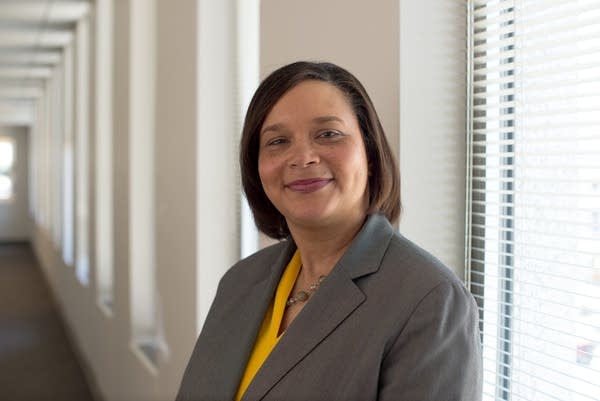Minnesota minority firms call program meant to help them maddening, broken

Go Deeper.
Create an account or log in to save stories.
Like this?
Thanks for liking this story! We have added it to a list of your favorite stories.
Philip Denny once hoped getting his company certified as a minority contractor with the state of Minnesota would open doors to state business. That was 16 years ago. He's won zero contracts.
Denny, an African-American whose Minneapolis information technology firm, Denysys, has been contracting for years with the federal government, can't explain why he's been shut out repeatedly on bids for state work.
"I don't beat my head against the wall anymore trying to find business with the state," he said.
That frustration is real for many Minnesota minority firms. Data show contractors of color get a sliver of the state procurement pie worth about $2 billion annually, despite a state program built to help them win more of that business.
Turn Up Your Support
MPR News helps you turn down the noise and build shared understanding. Turn up your support for this public resource and keep trusted journalism accessible to all.
Between July 2014 and June 2015, for instance, only eight certified black vendors were awarded contracts from state government agencies. The contracts totaled $141,972 — .008 percent of the $1.8 billion the state spent on projects and services from construction to janitorial to food services.
Minorities as a whole were awarded $14.3 million, less than 1 percent of the state's total spending.
"If that's not woefully inadequate, I don't know what is," said Gary L. Cunningham, president and CEO of Metropolitan Economic Development Association, a Minneapolis-based nonprofit that offers business solutions to minority entrepreneurs.
Even state officials don't deny their system is flawed and insufficient.
"It's unacceptable," said Matt Massman, commissioner of the Minnesota Department of Administration, which oversees state procurement. "The numbers need to be better, and we are focused and committed to doing that."
The state's response to the problem — a multimillion-dollar overhaul from computer upgrades to increased community outreach launched a year ago — has already boosted spending and new certifications. The state was even touted nationally earlier this year for its governor-led, diversity-minded procurement initiatives.
"Gov. Dayton has placed a very high priority on eliminating economic disparities and creating equity for everyone and making sure everyone has an opportunity to participate in a successful economy across the board," Massman said. "We want to be looking at opportunities that the state has to improve and eliminate those disparities."
But racial inequity in state procurement isn't new and neither are its solutions.
Program 'a joke'
The state's approach to achieving a diverse supply chain is known as Targeted Group certification. The program was created to give socially and economically disadvantaged small businesses a fair shot at state contracts.
It awards up to a 6-percent bidding preference to African-American, Latino, Asian- and American Indian vendors, as well as small white-owned firms operated by women, veterans, disabled, or located in what government considers economically disadvantaged areas, such as rural Minnesota.
Karen DeYoung has won steady contracts from the state over the past decade. Her Minneapolis business was one of the eight black-owned firms awarded contracts last budget year.
"I get a fair amount of work from the state but it's not due to interaction with the state; I'm not engaging with them at all," said DeYoung, who employs four at DeYoung Consulting. "I have had to figure out everything on my own and build those relationships. But a lot of my colleagues haven't figured it out. There is a problem."
The decades-old preference program shows little preference, minority vendors say, and the complex but toothless process can be easily manipulated. Layered with deficiencies, even longtime contractors are flummoxed. They say it's hard to navigate the system, like where to find requests for proposals.

Some contractors say state procurement mostly benefits white vendors who have traditionally done business with the state.
"It's a clique thing," said Jackie Williams, an African-American caterer who first certified her business, Abundant Catering, in 2004. She earned $244.03 last fiscal year in a one-time contract to provide boxed lunches. Lucrative, long-term projects tend to go to incumbent contractors, she said.
"But I want to be a part of the mix. I'm missing opportunities," Williams said, "and I've done everything I'm supposed to do. It's very frustrating."
Asha Abukar, new to the world of government contracts, changed her Minneapolis-based transportation company to a translation and interpretation business, thinking those services were more in demand by the state. But the 30-year-old still has no contracts and the process remains daunting.
"I don't even know where to go, to be honest," she said. "I joined the Targeted hoping it would give me a chance, but it didn't."
However, Vivian Guerra, who's logged decades in the construction industry, knows the game, and she's tired of it. The certified American Indian vendor seeks subcontracting opportunities. On contracts of $500,000 or more, Minnesota requires companies to hire minority or other Targeted Group subcontractors. The state, however, doesn't check invoices to make sure they're in compliance.

Guerra gets calls from contractors inviting her to submit bids to subcontract on state business — but then nothing happens.
"It's like crickets," said Guerra, co-owner of Adobe DeSigns, a Minneapolis-based signage company.
"They know they have to reach out to [Targeted Group] businesses with solicitations but that's all they do because the state doesn't follow up after that," she said. "That whole good faith effort thing is a joke."
The state had 45 certified American Indian vendors by the end of last fiscal year. Within that group, a total of three contractors won the smallest share, or $73,147, in fiscal year 2015.
Thirty of the 102 certified Asian-American contractors were awarded $12 million, the most in any other group of certified minority vendors. Fourteen Latino vendors out of 56 certified won $2.2 million.
Black contractors, with the most certified businesses at 149 and only eight contracts, disproportionately fared the worst.
According to data from last fiscal year, 4.3 percent of the state's business was done with the entire Targeted Group. Overall, white contractors comprised 69 percent of Targeted Group businesses according to figures as of Dec. 1, 2015, and won $63.1 million of the nearly $78 million spent within the group. White women, the largest certified group, accounted for $41 million.
But observers say equity in contracting could be a boon for entrepreneurs of color who lead new business starts and job growth statewide but are often cash-strapped.
"If minorities got 5 to 10 percent of contracts that would be quite a bit of money going into their businesses," Cunningham said. "It could be very lucrative and have huge implications for their cash flow and their sales."
From 2002 to 2012, minority-owned businesses grew by 118 percent, compared to 10.3 percent for all firms in the state, according to U.S. Census data. Their operations numbered more than 47,000 — almost 10 percent of businesses in the state — and blacks helmed nearly half of them. Together, the minority firms boasted $8.7 billion in sales, the data showed.
"The utilization of minority firms is not about benevolence; this isn't a social welfare program," said Darryl Peal, executive director of the Office for Business & Community Economic Development at the University of Minnesota.
"This is about creating economic impact in the communities where we all live, work and raise our families," Peal said. "Small businesses hire and create more jobs than anybody else. And if we're going to grow our local economy, it's essential we empower minority and small businesses."

Law not enforced
State officials acknowledge problems run deep. Minnesota has never set spending goals based on race or gender or used contract set-asides. It's never had staff devoted to supplier diversity. It's never tracked or monitored spending with diverse businesses. And it's never had outreach or support tailored to the unique needs of minority vendors.
A 1975 statute compels the state to allocate 25 percent of all contracts to small businesses, but the law is not enforced.
"These programs have been in place for 40 years," said Cunningham, "and, at the state level, they've been pretty dysfunctional."
In 1990, the Targeted Group was created to break down barriers to contracting, but until July 2015, less than one full-time employee was responsible for receiving and processing certification applications, doing outreach and monitoring subcontracting goals and overall spending.
It's possible minority vendors not certified or not eligible for Targeted Group also won contracts, but the state doesn't track race and gender of vendors outside of the program. Subcontracting payments also may have buoyed minority spending totals but that data isn't culled either.
The fundamentals of a successful supplier diversity program were never implemented in Minnesota, Peal said.

"You have to have an office and infrastructure, policy and procedure. But the implementation, support, monitoring and compliance of supplier diversity initiatives have to have staff to do them," he said. "You also need technology and software to help you gather the data. This work is not easy work, and it doesn't just happen on its own."
For example, St. Paul, with a fraction of the state's spending power, awarded $35.7 million, or 5.9 percent, to contractors of color in 2015, compared to the state's $14.3 million, or less than 1 percent.
St. Paul participates in CERT, a joint certification program with Ramsey and Hennepin counties that not only certifies small businesses but engages them with requests for proposals, updates and weekly procurement know-how workshops at Rondo Community Library. Additionally, the city operates a separate outreach program to create a pipeline of new suppliers.
And like the state, St. Paul has a 25 percent small business goal. But the city enforces and exceeds it. Embedded in that goal are gender- and race-based targets — 5 percent for minorities, 10 percent for women and 10 percent for small businesses. Last year, small businesses as a whole accounted for more than $242 million or 40 percent of the city's total spending, excluding its housing development funds.
A 2009 disparity study showed while minority and women vendors were available and capable, state agencies failed to use them. The study recommended aspects of the overhaul that's taking place now. It also urged creating a 25-percent target to boost spending with small businesses and diverse vendors.
"There was already legislation but the state was not enforcing it; we recommended the state do so," said Reggie Smith, vice president of disparity research for the national consulting firm MGT of America.
'Never had the bandwidth'
Massman, the state commissioner, said an overhaul takes money.
"We know what the challenges are; we've studied the challenges, and we're focused on getting the resources to implement them," Massman said. The Legislature approved $1.23 million last year on the recommendation of the governor to fund the overhaul. Another $1 million was appropriated this year to build the state's first procurement computer system.
"We never had the bandwidth," Massman said. "It helps explain why the numbers are low."
But the key pieces to create the infrastructure necessary to finally bridge minorities with state contracting opportunities are now in place, Massman said.
"We want to make sure, not only are we helping with [minority business] success, but we, as a purchaser of goods and services, are tapping into that growing market segment, so we are helping expand our current and future competition and price," Massman said, adding that he's using his executive power to thumb through requests for proposals and set aside contracts exclusively for Targeted Group firms. He says that's a first for his position.

The state also created a contracting practices committee, a collection of business leaders and experts from underrepresented communities to come up with strategies for equitable contracting. The U of M's Darryl Peal and Meda's CEO Cunningham serve on the committee.
The Office of Equity in Procurement, staffed with seven employees, opened last July.
Recent software upgrades created a vendors' web portal and moved diverse businesses to the top of the state's list of all available vendors so buyers see and potentially reach out to them first. And dashboards, newly installed, monitor each department's spending habits and use of diverse vendors. A weekly electronic newsletter is also dispatched to vendors with information about contracting opportunities.
Outreach efforts to boost minority firms in the supply chain are more plentiful. The state's first small-business procurement fair was held in March and attracted 300 entrepreneurs who met face-to-face with state purchasers.

Diversity training for the 800 state workers authorized to make purchases is now mandatory.
There's been legislative changes to streamline and boost certifications and successful bidding. Contractors with federal certifications no longer need separate Targeted Group certification to do business with the state. And the Targeted Group's longstanding preference cap was lifted from $500,000 to $1 million. Additionally, for projects under $25,000 solicitations are no longer needed if agencies contract Targeted Group vendors.
The administration department plans to team up with a new office within the Department of Employment and Economic Development to ready more minority firms for supplier work, creating a pipeline. And the findings of a disparity study this year will determine if the state will implement goals based on race and gender, a first for the state.
"I think we are making great progress," said Alice Roberts-Davis, an assistant commissioner in the Department of Administration who heads the state's Office of Equity in Procurement. She once led Target Corp.'s billion-dollar supplier diversity initiative. "We have been working very diligently, at first to put in the foundation for the program, and now moving it to be operationalized. We've done more outreach this year than we've ever done probably in the history of the program."

Vikings stadium a model?
Denny remains skeptical that he'll ever be able to work with the state. He's sticking with what's worked. Federal projects — 70 percent of his business — have been steady. His company employs 18 and is currently busy with five prime and subcontracts with five federal agencies.
"The state doesn't care about minority businesses — it's all lip service," he said. "That's what it's been for years."
But the most recent data released by the state suggest its efforts may be paying off: Spending with black vendors increased almost five-fold — from $141,972 in fiscal year 2015 to $707,839 in the fiscal year just ended, according to preliminary figures. New certifications spiked 34 percent this year over the year before.

"I can safely say there's not a single day I don't spend some time on supplier diversity and improving the system," Massman said. "There's really systematic changes that we're taking a look at that I think are going to benefit not just women and minority-owned, but all businesses."
Peal, who formerly worked as deputy director of the Ohio Department of Administrative Services Equal Opportunity Division, led the effort that resulted in Ohio meeting, and beating, its 15 percent goal for minority spending for the first time in 35 years in 2015. The changes in Minnesota could bring a similar outcome.
"Unless you have infrastructure that is intentional and methodically designed, to create success for minority vendors, you're not going to have success," he said, adding with the training, new office and committee, "Minnesota is setting itself up for success."
The new Vikings stadium might be a sign of the way forward.
The state insisted minority and women workforce account for 32 percent. The project surpassed it.
Vivian Guerra's company, Adobe DeSigns, was subcontracted to install 2,500 signs in and outside of the facility.
"It's our biggest project to date," she said. "It's led to new projects from the stadium sponsors — major corporations."




